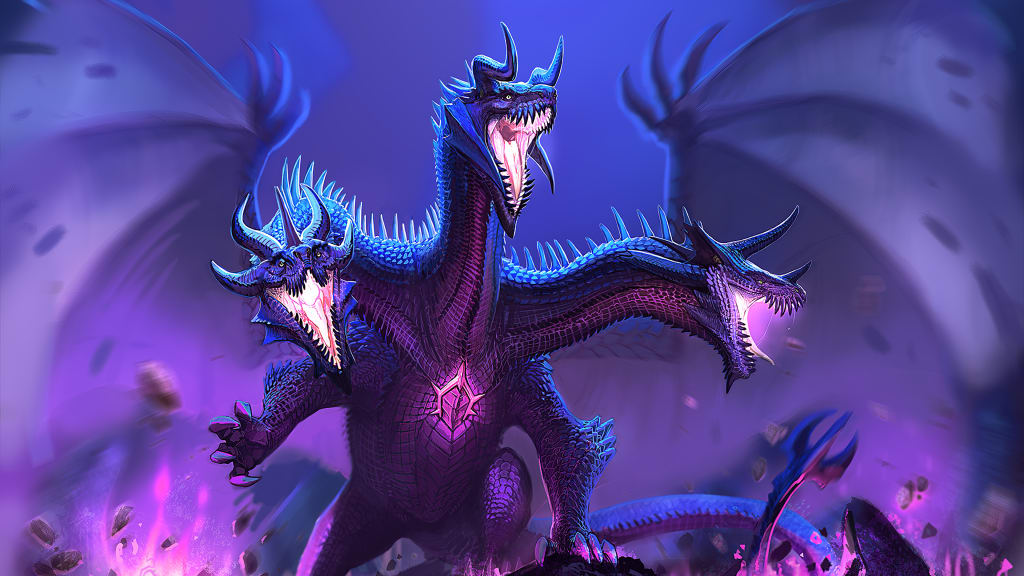Untold History Of Dragon🐉
1.Many dragon legends originate from ancient cultures such as China, Japan, and Europe. 2.In many cultures, dragons are seen as powerful, fearsome creatures associated with fire and destruction. 3.In some cultures, dragons are also seen as wise and benevolent creatures, associated with wealth and good luck. 4.The word "dragon" comes from the Greek word "drakon," which means "serpent" or "giant snake." 5.Some ancient cultures, such as the Chinese, believed that dragons were real creatures that lived in the sea or rivers. 6.In medieval Europe, dragons were often depicted as winged, fire-breathing creatures with four legs. 7.Many ancient cultures, such as the Chinese, had dragon-like creatures in their artwork and sculptures dating back to the Neolithic period. 8.In some cultures, dragons are also associated with rain, thunder, and lightning. 9.The Western dragon is typically depicted as a large, fearsome creature with wings, sharp claws and teeth, and the ability to breathe fire. 10Some dragons are known to hoard treasure and are often depicted guarding treasure hoards.

1.Many dragon legends originate from ancient cultures such as China, Japan, and Europe.
Dragon legends and myths have been present in various cultures throughout history. In ancient China, dragons were seen as powerful and benevolent creatures that were associated with wealth and good luck. In Japan, dragons were also seen as powerful and respected creatures, often associated with water and rain. In European culture, dragons were often portrayed as fearsome, fire-breathing beasts that were often defeated by knights. These legends and myths have been passed down through generations and continue to be a part of cultural tradition and storytelling.
2.In many cultures, dragons are seen as powerful, fearsome creatures associated with fire and destruction.
Dragons are often portrayed as powerful, fearsome creatures that are associated with fire and destruction. This is particularly true in Western culture, where dragons are often depicted as large, fire-breathing beasts that can cause great destruction. In ancient mythology, dragons were often seen as symbols of chaos and disorder, and were often defeated by heroes or gods. In some cultures, dragons were also associated with natural disasters like hurricanes and earthquakes, which were seen as the dragon's breath or rage. In many cultures, dragons are also seen as powerful, dangerous creatures that must be defeated or controlled in order to bring peace and safety to the community.
3.In some cultures, dragons are also seen as wise and benevolent creatures, associated with wealth and good luck.
Dragons are also seen as wise and benevolent creatures, associated with wealth and good luck. This is particularly true in Asian cultures, where dragons are often portrayed as powerful yet benevolent creatures. In Chinese culture, dragons are seen as symbols of good fortune, success, and prosperity. They are also associated with the emperor, and were seen as symbols of imperial power and authority. In Japan and Korea, dragons are also seen as powerful and respected creatures, often associated with water and rain. They are also seen as symbols of good luck, and it's believed that by having a dragon image or image of dragon on one's roof will bring good luck. The dragon is also revered for its wisdom and intelligence, and is often depicted as a wise and respected creature that brings good fortune to those who are fortunate enough to encounter it.
4.The word "dragon" comes from the Greek word "drakon," which means "serpent" or "giant snake."
The word "dragon" comes from the Greek word "drakon" which means "serpent" or "giant snake." The word drakon is derived from the verb "derkomai" which means "to see clearly" or "to watch", referring to the dragon's ability to see everything. In ancient Greece, the word drakon was used to describe both real and mythical snakes, including large serpents and dragons. The Greek dragon was often depicted as a large serpentine creature with sharp teeth and claws, and was often associated with chaos and destruction. The word "drakon" was then adopted by the Romans, and eventually made its way into other European languages, becoming the word "dragon" that is used today.
5.Some ancient cultures, such as the Chinese, believed that dragons were real creatures that lived in the sea or rivers.
Some ancient cultures, such as the Chinese, believed that dragons were real creatures that lived in the sea or rivers. In Chinese mythology, dragons were considered to be powerful, divine creatures that controlled the elements, particularly water. They were often associated with rivers, seas, and oceans, and were believed to have the power to control the weather and bring rain. Chinese dragons were also believed to live in caves, under the sea, or in the clouds, and were considered to be the ruler of all creatures that lived in the water. The Chinese dragons were also seen as the protectors of the people, and it was believed that they had the power to bring good luck and prosperity. The Chinese dragon is also represented in the Chinese astrology and considered as one of the 12 zodiac animals.
6.In medieval Europe, dragons were often depicted as winged, fire-breathing creatures with four legs.
In medieval Europe, dragons were often depicted as winged, fire-breathing creatures with four legs. They were often portrayed as fierce and deadly beasts that terrorized villages and towns, and had to be defeated by brave knights or heroes. These European dragons were heavily influenced by the stories and legends brought back by Crusaders and traders from the Middle East, where stories of winged serpents, known as "wyverns", were common. These dragons were also influenced by the Greek and Roman dragons, which were serpentine creatures associated with chaos and destruction. The depiction of dragons with wings and the ability to breathe fire were a later addition to the European dragon tradition, which has its roots in the depiction of dragons in the Middle East.
7.Many ancient cultures, such as the Chinese, had dragon-like creatures in their artwork and sculptures dating back to the Neolithic period.
Many ancient cultures, such as the Chinese, had dragon-like creatures in their artwork and sculptures dating back to the Neolithic period. The earliest known dragon-like depictions come from China, and date back to around 4000 BCE. These early dragon-like figures were often found on pottery and jade carvings and were portrayed as long, sinuous creatures with a snake-like body and a tail. These early dragon figures were often associated with water and were believed to have power over the elements.
As time passed, the dragon figures in Chinese art and sculptures became more complex and detailed, with the addition of features such as legs, horns, and the ability to breathe fire. These dragon figures were also associated with the imperial power and were often found in the imperial palaces and tombs. They also appeared on textiles, ceramics, metalwork, and other forms of art.
In other ancient cultures such as Mesoamerica, ancient Egypt, and the Indus Valley Civilization, also have dragon-like figures in their art and sculptures which often have similarities to the Chinese dragons, but have distinct features unique to their culture.
8.In some cultures, dragons are also associated with rain, thunder, and lightning.
In some cultures, dragons are also associated with rain, thunder, and lightning. This is particularly true in cultures where dragons are seen as powerful and benevolent creatures that control the elements. In Chinese mythology, for example, dragons are associated with water and are believed to have the power to bring rain, making them important figures in agriculture. They were also associated with thunder and lightning, and it was believed that the sound of thunder was caused by the beating of a dragon's wings.
In Japan, dragons are also associated with rain, and it is believed that they have the power to control the weather. Japanese dragons are often depicted with large eyes, which are said to be able to see everything, including the clouds. They are also said to have the power to make it rain, and in many traditional Japanese art, dragons are shown holding a jewel in its claws which symbolizes the power to create and control the clouds and rain.
In other cultures such as Norse, the dragons are also associated with thunder and lightning. Jörmungandr, a dragon in Norse mythology was believed to have the power to create thunder and lightning.
9.The Western dragon is typically depicted as a large, fearsome creature with wings, sharp claws and teeth, and the ability to breathe fire.
The Western dragon is typically depicted as a large, fearsome creature with wings, sharp claws and teeth, and the ability to breathe fire. The western dragon is often portrayed as a massive, winged reptile with a long tail, sharp claws and teeth, and the ability to breathe fire. They are usually portrayed as dangerous beasts that hoard treasure and terrorize villages and towns. This depiction of dragons has its roots in the medieval European folklore and legends, where dragons were often portrayed as fierce and deadly beasts that had to be defeated by brave knights or heroes.
The Western dragon is also often portrayed as a symbol of evil, malice, and greed. They are often depicted as greedy creatures, hoarding treasure and attacking villages and towns in search of more. The dragon is also often portrayed as a powerful, fearsome opponent that can only be defeated by the bravest and strongest of heroes.
In literature, the Western dragon has been an enduring symbol of fear, power, and evil, appearing in countless stories, fables, and fairy tales. They have also been a popular subject in fantasy literature, games and movies in recent times.
10.Some dragons are known to hoard treasure and are often depicted guarding treasure hoards.
Some dragons are known to hoard treasure and are often depicted guarding treasure hoards. This is particularly true in Western dragon mythology, where dragons are often portrayed as greedy creatures that hoard treasure and attack villages and towns in search of more. The treasure hoard of a dragon is often depicted as a pile of gold, jewels, and other valuable items that the dragon has collected over time.
In literature and folklore, dragons are often depicted as guarding their treasure hoards fiercely, and will attack anyone who tries to steal from them. In some stories, dragons are depicted as guarding their treasure hoards for centuries, only to be defeated by a brave knight or hero. The treasure hoard is often a central element of the story, with the hero going on a quest to defeat the dragon and claim the treasure as a reward.
In some cultures, dragons hoarding treasures is also seen as symbol of abundance and wealth, in which the dragon's hoard was a source of prosperity and good luck. The dragon's hoard is also often associated with the dragon's power and strength, as the ability to acquire and keep a large treasure hoard is a sign of the dragon's might and dominance.
About the Creator
BVT
Life is a Book
Every Day a new Page,
Every Month a new Chapter,
AND
Every Year a new Series.
Enjoyed the story? Support the Creator.
Subscribe for free to receive all their stories in your feed. You could also pledge your support or give them a one-off tip, letting them know you appreciate their work.






Comments
There are no comments for this story
Be the first to respond and start the conversation.